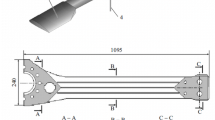Abstract
A technique for identification of hereditary properties under conditions of short-time creep of Plexiglas is developed. The technique is based on experimental determination of shifting of the center of decaying flexural vibrations of vertically aligned test samples after their preliminary maintaining in a static bent state. Mathematically, the technique is based on using the finite element method and integral equations of the theory of hereditary viscoelasticity with the Koltunov–Rzhanitsyn hereditary kernel. An object function is constructed for identification of rheological parameters of this kernel. The minimum of this function is found by the direct search method, which does not require the function gradient to be known. The hereditary kernel of Plexiglas averaged on the basis of data for several test samples is obtained as a function of time.
Similar content being viewed by others
References
R. A. Rzhanitsyn, Creep Theory (Gosstroiizdat, Moscow, 1968) [in Russian].
V. V. Khilchevskii and V. G. Dubenets, Scattering of Energy in Vibrations of Thin-Walled Elements of Structures (Vishcha Shkola, Kiev, 1977) [in Russian].
N. V. Vasilenko, “Allowance for Imperfect Elasticity of the Material with Mechanical Vibrations by the Method of ComplexModuli,” in Scattering of Energy in Vibrations of Mechanical Systems (Naukova Dumka, Kiev, 1974), pp. 5–12 [in Russian].
V. S. Postnikov, Internal Friction in Metals (Metallurgiya, Moscow, 1969) [in Russian].
E. S. Sorokin, On the Theory of Internal Friction in Vibrations of Elastic Systems (Gosstroiizdat, Moscow, 1960) [in Russian].
A. Nashif, D. Jones, and J. Henderson, Vibration Damping (John Wiley and Sons, New York, 1985).
Bo Liu, Liang Zhao, A. J. M. Ferreira, et al., “Analysis of Viscoelastic Sandwich Laminates Using a Unified Formulation and a Differential Quadrature Hierarchical Finite Element Method,” Composites, Pt. B, Eng. 110 (1), 185–192 (2017).
V. G. Dubenets and V. V. Khilchevskii, Vibrations of Damped Composite Structures (Vishcha Shk., Kiev, 1995) [in Russian].
V. N. Paimushin, V. A. Firsov, I. Gyunal, and A. G. Egorov, “Theoretical-Experimental Method of Determining the Damping Parameters on the Basis of Studying Decaying Flexural Vibrations of Test Samples. 1. Experimental Basis,” Mekh. Kopoz. Mater. 50 (2), 185–198 (2014).
A. P. Bronskii, “Afteraction Phenomenon in Solids,” Prikl. Mat. Mekh., No. 1, 31–56 (1941).
Yu. N. Rabotnov, “Equilibrium of an Elastic Medium with an Afteraction,” Prikl. Mat. Mekh. 12 (1), 53–62 (1948).
Yu. N. Rabotnov and S. T. Mileiko, Short-Time Creep (Nauka, Moscow, 1970) [in Russian].
N. N. Malinin, Applied Theory of Plasticity and Creep (Mashinostroenie, Moscow, 1975) [in Russian].
N. V. Kolebina, V. L. Danilov, and S. Prizhan, “Investigation of Short-Time Creep of Advanced Turbine Steel,” Nauka Obraz., No. 11, 771–779 (2014).
N. A. Katanakha, A. S. Semenov, and L. B. Getsov, “Unified Model of Long-Time and Short-Time Creep and Identification of its Parameters,” Probl. Prochn., No. 4, 143–157 (2013).
M. Yu. Belomytsev and S. V. Mordashov, “Regular Features of Short-Time Creep of St. 3 Steel,” Izv. Vyssh. Ucheb. Zaved., Chern. Metallurg. 58 (11), 798–802 (2015).
Yu. N. Rabotnov, Creep Problems in Structural Members (Nauka, Moscow, 1966; North-Holland, Amsterdam, 1969).
N. V. Vasilenko, “Stress–Strain Dependence in Real Isotropic Bodies,” in Scattering of Energy in Vibrations of Elastic Systems (Naukova Dumka, Kiev, 1966), pp. 94–103 [in Russian].
Ya. G. Panovko, Internal Friction in Vibrations of Elastic Systems (Fizmatgiz, Moscow, 1960) [in Russian].
G. S. Pisarenko, Vibrations of Mechanical Systems with Allowance for Imperfect Elasticity of the Material (Naukova Dumka, Kiev, 1970) [in Russian].
M. A. Koltunov, Creep and Relaxation (Vysshaya Shkola, Moscow, 1976) [in Russian].
M. A. Koltunov, V. P. Maiboroda, and V. G. Zubchaninov, Strength Calculations of Articles Made of Polymer Materials (Mashinostroenie, Moscow, 1983) [in Russian].
T. Shoup, A Practical Guide to Computer Methods for Engineers (Prentice-Hall, Englewood Cliffs, 1979).
R. W. Clough and J. Penzien, Dynamics of Structures (McGraw-Hill, New York, 1975).
Author information
Authors and Affiliations
Corresponding author
Additional information
Original Russian Text © V.N. Paimushin, V.A. Firsov, V.M. Shishkin.
Translated from Prikladnaya Mekhanika i Tekhnicheskaya Fizika, Vol. 59, No. 3, pp. 155–168, May–June, 2018.
Rights and permissions
About this article
Cite this article
Paimushin, V.N., Firsov, V.A. & Shishkin, V.M. Identification of Parameters of Short-Time Creep of Plexiglas By Means of Studying Decaying Flexural Vibrations of Test Samples. J Appl Mech Tech Phy 59, 519–530 (2018). https://doi.org/10.1134/S0021894418030173
Received:
Published:
Issue Date:
DOI: https://doi.org/10.1134/S0021894418030173




